When the doors to the Wynn Las Vegas opened at 12am on April 29, visitors stormed the entrance to see if Steve Wynn's US$2.7 billion luxury resort would live up to all the hype. Throngs clamored for a view of the waterfall behind the coniferous tree-covered mountain, a taste of Daniel Boulud's first Las Vegas restaurant or a round on the 18-hole golf course.
For me, it all came down to pure retail, with a burning question that sparked a pilgrimage from my home in Los Angeles: Could the Wynn Esplanade, a massive collection of high-end shops, measure up to Las Vegas' war horses, like the Forum Shops at Caesars Palace or the earlier Wynn creation, Via Bellagio? With such a dense concentration of stores on the 3km Strip, the "what happens here, stays here" vibe and the calculated luxury of the "esplanades," "vias" and "shoppes," even the most seasoned shopper can be rendered utterly defenseless.
And they say gambling is addictive.
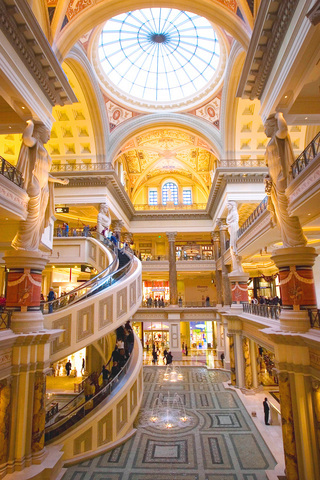
PHOTOS: NY TIMES NEWS SERVICE
For hard-core shoppers, even Banana Republic seems alluring. Every glassed-in mannequin sings a siren song. And suddenly, you find yourself in stores you wouldn't normally be drawn to, indulging in clothes you wouldn't normally wear and spending money you don't have. Or, in my case, wading through kilometers of storefronts just to size up the new kid on the block.
Las Vegas shopping is like most things the town does well: It's simply bigger, better and more fun.
The stores are not just stores, they're the backdrop for shoppertainment. At the Grand Canal Shoppes at the Venetian, singing gondoliers spirit shoppers down a winding canal while street performers entertain those on foot. Desert Passage, the mall at the Aladdin, has a Moroccan bazaar theme, replete with a manufactured thunderstorm that brews every half hour.
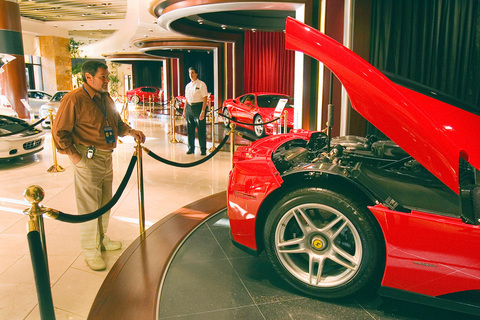
For my first stop, I chose the climate-controlled, color-morphing Mediterranean skies of the Forum Shops at Caesars, a colossal assemblage of designer stores attached to Caesars Palace. It is said to be the most lucrative shopping mall in the country. I marched past animatronic Bacchus and Venus sculptures, gigantic fountains, statues and colonnades, and climbed a spiral-shaped escalator -- all to get a sense of the real spectacle: the stores themselves.
There are just so many of them, from Diesel to Dior. The window shoppers peeped at the ornate Victoria's Secret, more burlesque show than store, and fogged up the display cases at the Tourneau Time Dome, the largest watch store in the country. Collectors bought Las Vegas keepsakes, ranging from a US$3.99 magnet depicting the "Welcome to Fabulous Las Vegas" sign, for sale at Magnets Maximus, to a US$320 pair of crystal dice, sold only in the Las Vegas outlet of Baccarat, the French crystal company. And even I had specialty shops to get excited about -- like Giuseppe Zanotti, the Italian shoemaker, and Scoop NYC, the chic sportswear boutique -- neither of which has an outpost in Los Angeles.
Despite the thick mass of people meandering around the Forum, the higher-end shops were deserted. (No worry: One high roller a day will meet the store's quota.) In the mod and colorful Emilio Pucci store, a salesperson pounced the moment I paused in front of a large, US$690 handbag -- hoping, no doubt, that I was today's big spender. "Fabulous. Bluebell print. You must have it, no?"
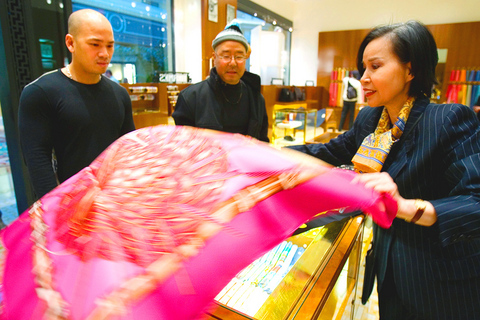
I demurred and after a few more failed attempts, he found readier prey in a woman who asked to try on some down-filled moon boots for US$250. Moments later, as the woman handed over her credit card, I asked her where she was from. "Western Florida," she said. Where it gets cold enough for moon boots? "It's a souvenir."
This was no ordinary shopping mall.
I could not say the same for the Fashion Show Mall, the other major shopping center on the Strip. It is huge: 600,000m2, to be exact. It has over 250 stores, including Saks Fifth Avenue and Nordstrom, an Apple store, and some smaller boutiques like Talulah G, which stocks the hard-to-find Chloe calfskin Paddington Bag for US$1,200 and True Religion jeans, which start at US$182.
But without significant shoppertainment -- save its rising runway that features flashy fashion shows three days a week -- you could be anywhere, to which I say: If you're going to be anywhere, you might as well get a discount. The Fashion Outlets of Las Vegas, a 30-minute drive from the Strip, in Primm, a town on the California border, offer merchandise similar to that at the Fashion Show's Neiman Marcus, BCBG and Cole Haan shops, for discounts of 50 percent and 60 percent.
It was time to hit the Wynn. In 1998, when Wynn opened the Via Bellagio, it was the first to lure such luxury retailers as Chanel, Giorgio Armani, Hermes and Prada to a Las Vegas resort. Since then, new high-end stores have appeared in lesser resorts, the Forum Shops have expanded (though the Gucci at the Bellagio, placed next to its Italian rivals, Fendi and Prada, seems more alluring than its Forum counterpart) and Wynn has sold the Bellagio.
Anticipating Steve Wynn's personal one-upmanship was making me wildly curious, so I hopped a cab for the 2km ride up Las Vegas Boulevard to the Wynn Las Vegas. Eleven minutes later, I arrived at the entrance, which I made the mistake of bypassing in order to visit the Penske-Wynn Ferrari-Maserati dealership at the other end of the grand circular drive. A warning: You can only access the showroom from inside the casino, and the line can be as long as the one for a Cirque du Soleil show. And if you're in the market for a new Ferrari (they start at around US$200,000), you'll have to wait for that, too, the dealership's allotment was sold out within two months of opening.
I'm not sure what I was expecting when I finally arrived at the Wynn Esplanade. A majestic choir, perhaps? An astounding array of luxury boutiques I had always wanted to shop in? Or relief for my aching feet? There was no choir, and although I spotted the first Las Vegas retail branches of Oscar de la Renta, Jean Paul Gaultier and Manolo Blahnik among the hallway of marquee-name shops, it was the comfort of the plush, parasol-patterned carpet beneath my feet that truly impressed. There was also a calm about the place, as if it were kilometers away from the din of the casino.
What differentiates the Wynn Esplanade is the Wynn experience. If there's a theme, it's "our palace is your palace." Shoppers and gawkers are equally represented, gazing up at the fabric-covered domes and pausing in front of the lush greenery.
Inside Cartier, when I said I was "just looking," I was given a glass of champagne and shown a specialty dice charm for US$3,150, made exclusively for the Wynn. You don't even need money: In Chanel, a woman without a purse paid US$1,795 for one just by showing her room key. I was studying a case of yellow diamonds at Graff, the London-based jeweler, when a middle-aged man in shorts, socks and sandals came in. "I was just hoping to take a picture of the marble floor," he said.
The salespeople smiled warmly. "No problem." You never know: Anyone could be a jackpot winner.
Viva Las Vegas!
Average temperatures are 19 degrees Celsius. Average yearly rainfall 10.64cm. Average daily humidity 29 percent. 211.5 clear days annually, 82.4 partly cloudy days, 71.3 cloudy days.
Other attractions:
Mount Charlestone for winter skiing, picnicking, hiking, horseback riding, tours available.
Death Valley, Zabiske Point, 20 Mule Canyon, Scotty's Castle, tours available.
Grand Canyon, about 480km from Las Vegas.
Lake Meade National Recreation Area, about 40km from Las Vegas, for shoreline, swimming, water skiing, camping, boating.
Hoover Dam, 54.4km from Las Vegas, 220m from bedrock, wonder of the modern world.
T Link Travel Service Co is quoting United Airlines, Monday to Thursday, at NT22,900 return. Weekends are more expensive at NT$45,000 round trip. Neither price includes tax. Call (02) 2562 9335.

May 26 to June 1 When the Qing Dynasty first took control over many parts of Taiwan in 1684, it roughly continued the Kingdom of Tungning’s administrative borders (see below), setting up one prefecture and three counties. The actual area of control covered today’s Chiayi, Tainan and Kaohsiung. The administrative center was in Taiwan Prefecture, in today’s Tainan. But as Han settlement expanded and due to rebellions and other international incidents, the administrative units became more complex. By the time Taiwan became a province of the Qing in 1887, there were three prefectures, eleven counties, three subprefectures and one directly-administered prefecture, with

Taiwan Power Co (Taipower, 台電) and the New Taipei City Government in May last year agreed to allow the activation of a spent fuel storage facility for the Jinshan Nuclear Power Plant in Shihmen District (石門). The deal ended eleven years of legal wrangling. According to the Taipower announcement, the city government engaged in repeated delays, failing to approve water and soil conservation plans. Taipower said at the time that plans for another dry storage facility for the Guosheng Nuclear Power Plant in New Taipei City’s Wanli District (萬里) remained stuck in legal limbo. Later that year an agreement was reached
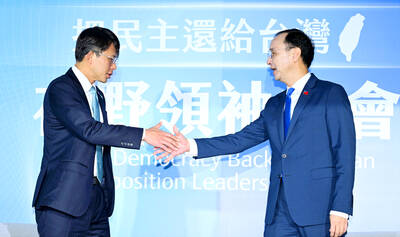
What does the Taiwan People’s Party (TPP) in the Huang Kuo-chang (黃國昌) era stand for? What sets it apart from their allies, the Chinese Nationalist Party (KMT)? With some shifts in tone and emphasis, the KMT’s stances have not changed significantly since the late 2000s and the era of former president Ma Ying-jeou (馬英九). The Democratic Progressive Party’s (DPP) current platform formed in the mid-2010s under the guidance of Tsai Ing-wen (蔡英文), and current President William Lai (賴清德) campaigned on continuity. Though their ideological stances may be a bit stale, they have the advantage of being broadly understood by the voters.
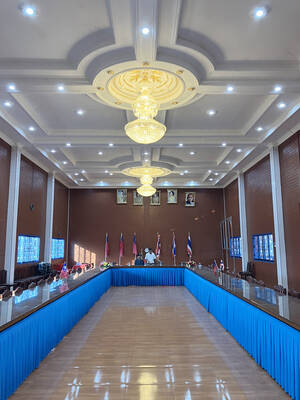
In a high-rise office building in Taipei’s government district, the primary agency for maintaining links to Thailand’s 108 Yunnan villages — which are home to a population of around 200,000 descendants of the Chinese Nationalist Party (KMT) armies stranded in Thailand following the Chinese Civil War — is the Overseas Community Affairs Council (OCAC). Established in China in 1926, the OCAC was born of a mandate to support Chinese education, culture and economic development in far flung Chinese diaspora communities, which, especially in southeast Asia, had underwritten the military insurgencies against the Qing Dynasty that led to the founding of